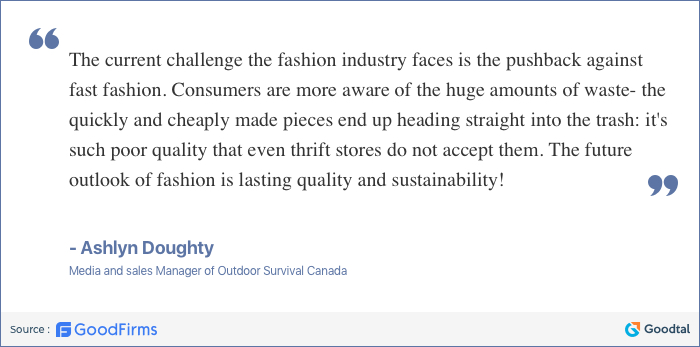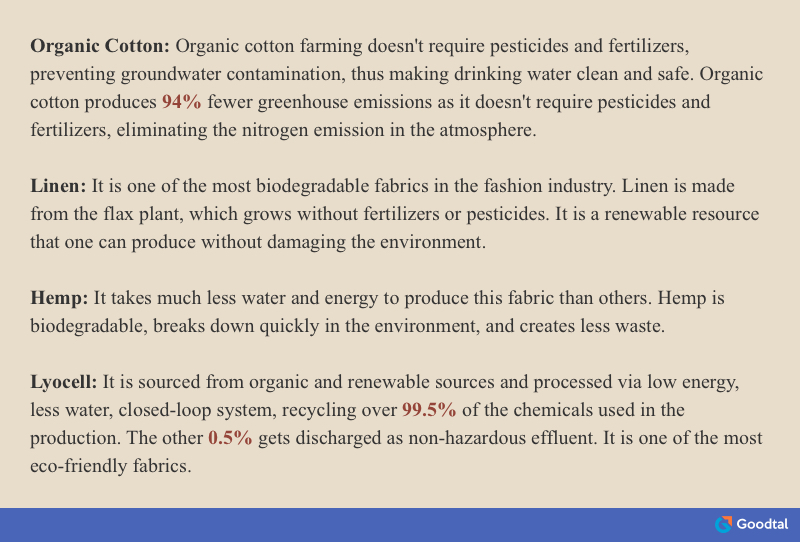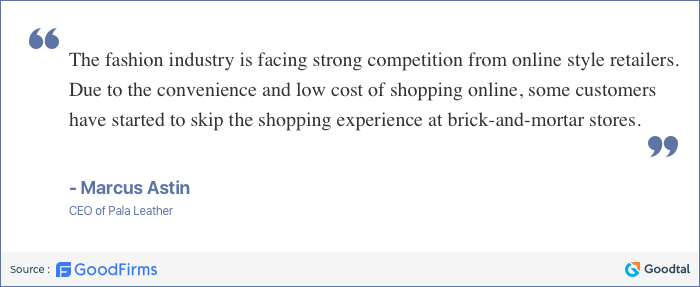
The fashion sector is one of the largest industries in the world. It is estimated that by the end of the decade, this industry will be worth more than $3T.
We are also witnessing newer innovations in this sector, like robots that sew and cut fabric, AI algorithms that predict style trends, and clothes that one can wear in virtual reality. Automation and better personalization of products are changing everything in the fashion industry.
But this industry has a fair share of problems regarding its environmental and social impact.
In this blog, let's explore the future of the Fashion Industry in 2022 and beyond based on GoodFirms research.
Fashion Choices Need to Be Sustainable
Much attention has been brought in recent years to the fashion industry's adverse impact on the environment. Here are some eye-opening stats regarding this:
- Approx 60% of all materials used by the fashion industry are made from plastics.
- The fashion industry is responsible for 8 - 10% of humanity's carbon emissions, more than all maritime shipping and international flights combined.
- The fashion industry uses approximately 93 billion cubic meters of water annually. It is enough to fulfill the needs of five million people. This industry is the reason behind the water scarcity in some regions.
- Around 20% of industrial wastewater pollution originates from the fashion industry.
- The equivalent of one garbage truck full of clothes is burned or dumped in a landfill every second.
Shocking, isn't it? We, too, felt it when seeing these stats. But it's the reality that people cannot afford to ignore.

Sustainable clothing is the need of the hour, and people are starting to realize it too. They want companies to come up with environmentally-friendly clothing styles.
A report by First Insight revealed that Gen Z strongly influenced not only their Gen X parents but even their boomer grandparents in sustainable shopping.
- Gen X consumers' preferences to shop for sustainable brands increased by approx 25%, and their willingness to pay more for such products increased by 42%.
- Only 58% of consumers across all generations were willing to spend more for sustainable options two years ago. Today, nearly 90% of Gen X consumers are willing to spend an extra 10% or more for environmentally friendly products, compared to just over 34% two years ago.
Business Insider revealed that Gen Z influence would only rise from here as the younger members of this group grow into adulthood. They will represent 27% of the world's income, surpassing millennials by 2031.
Over the years, there has been a distinct rise in Vegan fabrics and textiles. These are:

GoodFirms survey revealed that 35% of surveyees prefer purchasing from brands that provide information about their green initiatives.
Choosing sustainability will help save natural resources, reduce carbon footprint, save animal lives, and conserve water.
The Increasing Prominence of AI in the Fashion Industry
AI technologies are revolutionizing the fashion industry in different ways. Customers can use it to customize their clothes based on fabric, colors, and style preferences. It can collect data on customers to find out what suits them better.
Previously, humans handling this often conveyed their personal preferences when assisting others. But AI has no favoritism or biases and will choose what best fits the customer.
Artificial intelligence will help customers design precisely what they envisioned in their minds. It is changing how the fashion industry designs personalized products.
Customers will get specifically the product they want, whether it is a business suit or embroidery T-shirt.
AI builds data sets from thousands or millions of images and uses its algorithm to create original works. Human designers can complement it by reinterpreting and further improving the designs.
It has enabled virtual reality, allowing customers to try garments and shoes on a 3D avatar without actually wearing the product.
People will get a complete overview of an item, almost as if they were holding it in-store. Customers can use VR to customize their chosen products and see these changes in real time.
AI can also be beneficial for inventory management. It can help you decide on the latest fashion trends, which you can take advantage of by putting up specific products for display at the right time when people are looking for the most fashionable pieces of the season.
You can also install smart mirrors in your store to give the customers a top-notch experience. Consumers can look in the mirror and virtually try on different clothes and shoes without needing dressing rooms.
This mirror will give customers the best look possible by comparing multiple garments side-by-side and changing the colors to see what suits better to their skin tone and body shape.
The Rise of Online Shopping Apps
Customers like convenience, leading to a rise in online shopping apps. With such apps, consumers can purchase items from the comfort of their homes or workplace. Online shopping also provides better prices with coupons and discounts. It provides several options for people to compare prices from different stores.

As of 2020, there were roughly 7.8 billion people worldwide, and just over a quarter (26.28%) of them were online shoppers. There has been a marked increase in the number of digital shoppers. It has increased from 1.32 billion in 2014 to 2.05 billion in 2020.
Millennials between ages 25 to 34 comprised 20.2% of online shoppers in the USA as of Feb 2020, making them the country's most significant online shoppers.
The second largest online shoppers demographics were between 35 - 44 years old, accounting for 17.2% of US digital buyers.
Clothes are the major products that people purchase online. Easy return policies have made it attractive for shoppers to buy clothes online without the risk of purchasing something that may not fit them.
The pandemic boosted online shopping further as consumers avoided going to local markets due to the fear of Covid 19.
Having a mobile app enables customers to buy clothes from your stores online. We suggest checking out Goodtal to get a list of the top mobile app developers.
You will get end-to-end service at an affordable rate and a streamlined workflow. A mobile app will help you build a solid online presence on the internet.
Fashion Choices Should Be More Inclusive
One size doesn't fit all for humans. They have varying differences in body parts like cups, hips, and even waist. Andrea Kennedy made a report in 2017 for The Fashion Structure Journal, highlighting that 62% of customers cannot find clothes in related stores that fit them.
In 2019, Verena Erin, for My Green Closet, reported that over 75% of clothing sizes aren't correctly fitted.
As per Statista, the market value of plus-size women's apparel worldwide from 2019 - 2028 is estimated to be worth 178.5 billion US dollars. But in 2021, it declared that the plus-size clothing store industry was valued at 6.67 billion dollars, significantly declining from the 2019 value.
Approx 60% of shoppers are plus-size people, but they still struggle to find perfectly fitting clothes.
Queer, trans, and non-binary people are also on the losing end of inclusion in the fashion industry. Stonewall reported about 31% of non-binary people and 18% of Trans people weren't able to wear work attire that represented their gender expression.
Lack of personalization in clothing results in increasing returns.
CDC.GOV reported that as of 2020, 61 million adults in the United States live with a disability. 26% of adults in the USA have some disability. So, it's essential to be inclusive in garment production.
Inclusive fashion is when garments are designed to be useful for everybody, including the disabled community. Inclusivity is essential because people often cannot find clothes that fit or look good on their body type and skin tone.
A good representation gives confidence to people about themselves and makes them comfortable shopping at your store.
For Further Reading
Check out GoodFirms research on the global fashion industry. It shares in-depth insights into the fashion industry's different trends, challenges, and factors influencing customer buying decisions.
